Choreographer: Davida Monk
Dancers: Catherine Hayward, Mark Dela Cruz, Shayne Johnson, Serenella Sol, Sasha Wilde
Music: Natasha Barrett
Costumes: Angela Dale
Outside Eye: Linnea Swan
Rehearsal Assistant: Chantal Wall
Percussion Consultant: Robin Tufts
Photos: Tim Nguyen
The profound and ancient human kinship with all life is at the centre of this work. The movement vocabulary arises from a study of the crow, and of poetic images of crows in the work of Ted Hughes and Mary Oliver. The piece also attends to the poetic significance of tolling bells, as experienced in our lives, and as found, for example, in the work of Adam Zagajewski, The work incorporates a set with hanging bells which the dancers play at significant moments during the performance and bell sounds are integral to Barrett’s musical score.
The Heart of Ringing evokes a liminal world in which dancers are more than human.
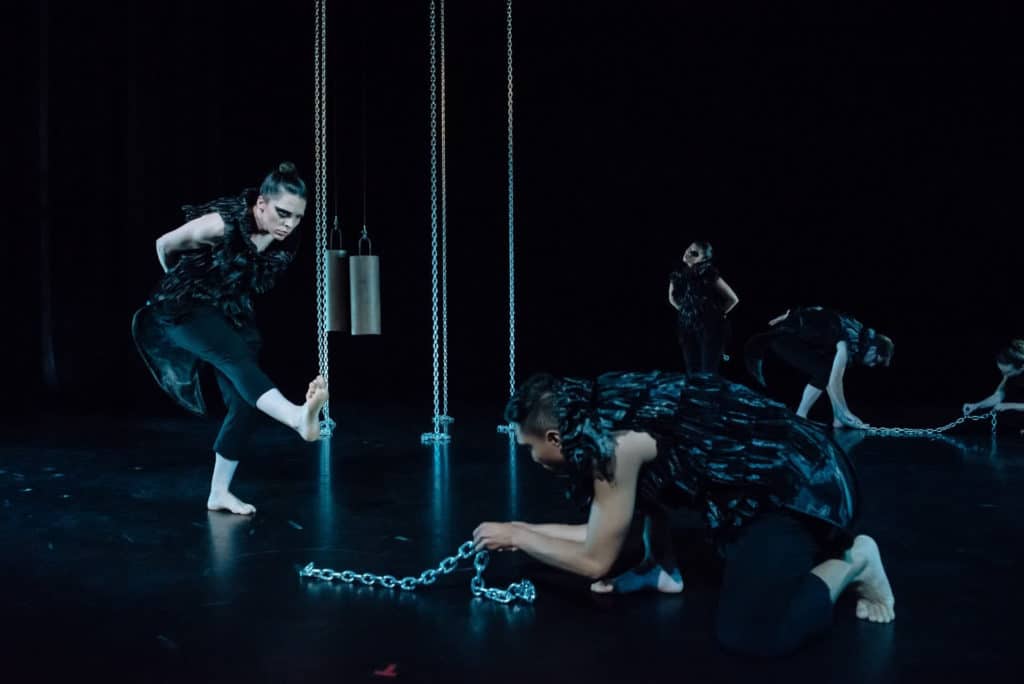
Choreographer: Davida Monk
Dancers: Nicole Charlton-Goodbrand, Catherine Hayward, Shayne Johnson, Brandon Maturino, Linnea Swan, Su Lin Tseng
Music: Allan Gordon Bell
Costumes: Angela Dale
Photographer: Tim Nguyen
Dancers: Nicole Charlton-Goodbrand, Valentia Dimitriou, Jared Tobias Herring, Meghann Michalsky, Rufi O. Rodriguez, Katharina Schier
Scotiabank Dance Centre, Vancouver May 23-25, 2019
Dancers: Naomi Brand, Shauna Elton, Erin O’Loughlin, Hilary Maxwell, Arash Khakpour, Walter Kubanek
Understudy: Meredith Kalaman
Rehearsal Assistant: Emmalena Fredriksson
“Give unto them beauty for ashes, the oil of joy for mourning, the garment of praise for the spirit of heaviness.” Isaiah 61:3
Ashes for Beauty draws its inspiration from two complementary sources: the profound transformations that are central to all human lives, including joy and suffering, and the evocative promptings of the natural world. Using these sources as movement subjects, the work seeks to express the persistent intensity and irrevocable change that is the incarnate experience. It asks the dancer to listen deeply to the inner urge to movement.
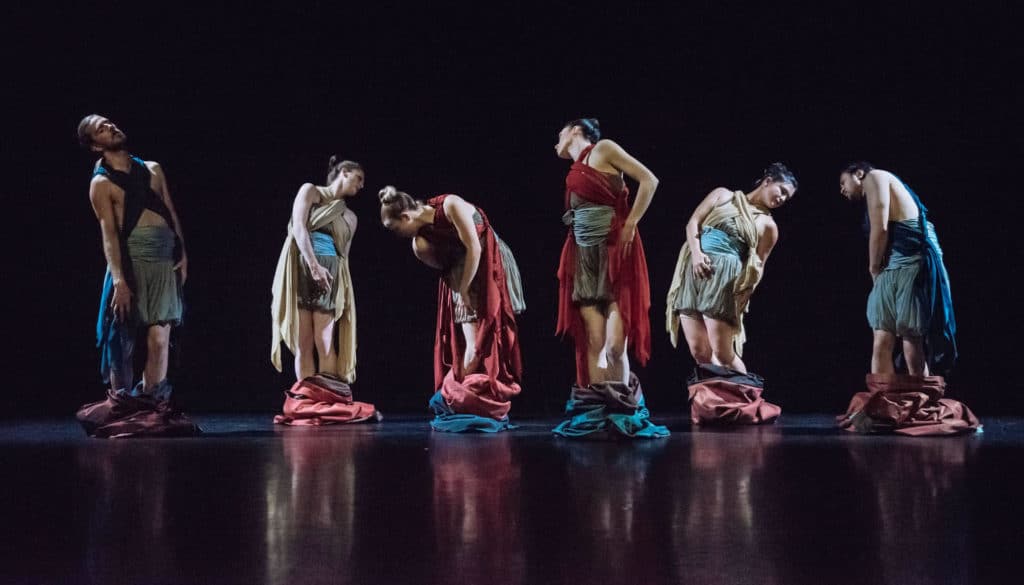
“If it is true that the act of theatre can transcend time, then our inner states surely embody our own largest theatre of mind and soul, perpetually immersed in extravagant feeling. Our ever-changing experiences seem to be continually magnified to larger-than-life levels, our emotions carrying us with an exaggerated kinesis through change after intensified change. Monk’s Ashes for Beauty captured how all inner theatre can be a drama of continual movement, always developing, never ceasing, ever becoming.” Stephan Bonfield
“The work is rhapsodic in its individual poetry, but compelling in its collective ensemble work too at many points, featuring momentary duos of spacious richness which can only come from an experienced well-practised combinatorial imagination. Monk choreographs with a seemingly endless surfeit of lyrical beauty. …The choreography and performance were both equally, totally enthralling.” Stephan Bonfield, The Calgary Herald, 2016
Choreographer: Davida Monk
Dancers: Valentia Dimitriou, Catherine Hayward, Shayne Johnson, Rufio Rodriguez
Music: Four Movements from Sweetgrass, Allan Gordon Bell
Costumes: Carey Lees
Choreographer: Davida Monk
Dancers: Valentia Dimitriou, Jared Tobias Herring, Meghann Michalsky, Sylvie Moquin, Rufi O. Rodriguez
Music: Four Movements from Sweetgrass, Allan Gordon Bell
Costumes: Angela Dale
Photos: Tim Nguyen
The dance-space-as-journey is expressed through the pathways and geometric intricacies of the Chartres labyrinth. The emotional content springs from the poetic contemplation of beauty, terror and the invisible in Rainer Maria Rilke’s Duino Elegies, and a variety of mystical writings on the nature of angels. The movement develops from a few simple root motifs to express contemplation, burden, hesitancy, bravura, terror and triumph. The dancers encounter many obstacles, not the least of which is their own fear, as they wrestle with the consequences of a profound call.
“ For beauty is nothing/But the beginning of terror, which we still are just able to
/Endure, / And we are so awed because it serenely disdains/To annihilate us. Every angel is terrifying.” Duino Elegies, Rainer Maria Rilke
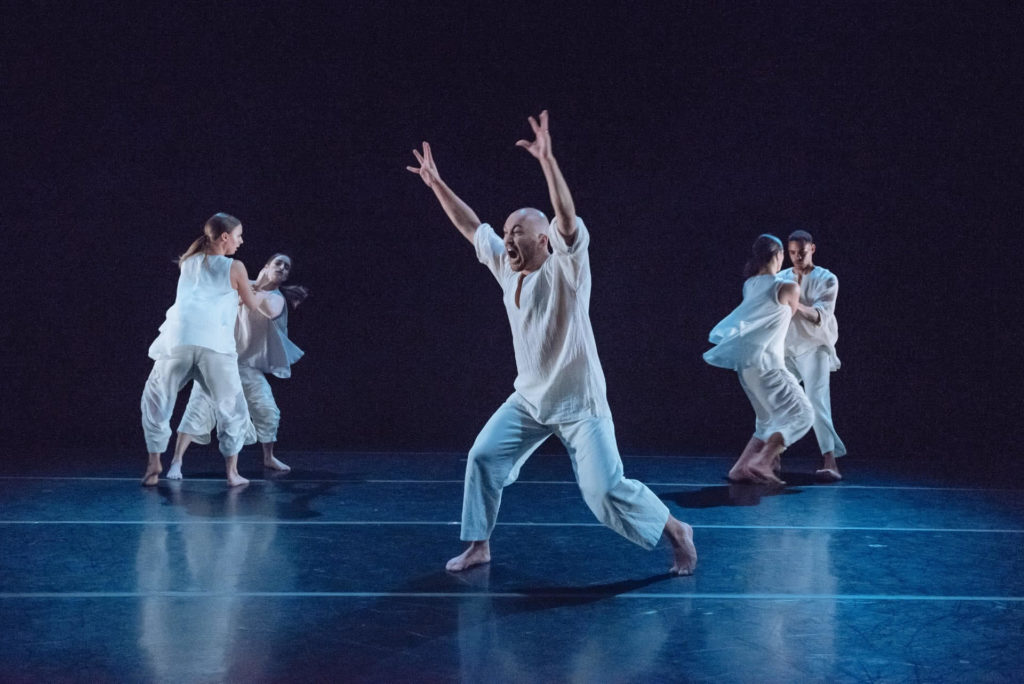
Choreographer: Davida Monk
Dancer: Shayne Johnson
Understudy: Dario Charles
Music: Innua: Three Masks by Allan Gordon Bell
According to Roberto Calasso and James Hillman, Pan is the wildest and most bestial of the gods, the master of the instinctual soul. A music man and a great dancer, he teaches us about rhythm and range. His dance comes from, and its intoxication leads us back to, the wild.
Photographer: Tim Nguyen
“The poles of sexuality and panic, which can instantly switch into each other or release each other, exhibit the most crassly compulsive extremes of attraction and repulsion. … Pan is a monster. He is a creature that does not exist in the natural world. His nature is imaginal, so too instinct is to be understood as an imaginal force …” James Hillman
Choreographer/Performer: Davida Monk
Musician/Performer: Bill Horist
Lighting Design: Graham Frampton
Costume Design: Robin Poitras
The Ice-Shirt (1990) is William T. Vollman’s opening novel in a series of what he describes seven dreams, immaculately researched works of historical fiction that re-envision the first contact of European and North American cultures. Putting on the Ice-Shirtevokes a wildness of spirit, mythic portent and dark beauty which it draws from Vollman’s telling of the Nordic peoples visits to North America circa 1000 C.E..
Premiered at the Sound Symposium, St. John’s Newfoundland.
Photographer Greg Locke
“ beautiful and strong. A really captivating & compelling idea of putting on an ‘Ice Shirt’, And your connection with Bill was tangible – was a complimentary arrangement, important and subtle listening going on, a ambient sensitivity to the space.” Calla Lachance
Choreographer: Davida Monk
Dancer: Becky Sawdon
Music: Ellipse, Robert Normandeau
Lighting: Steve Isom
Fabulous Beast vocabulary arises from the study of netsuke. The solo performer brings a fantastical array of beings alive in a dramatic sequence of juxtaposition and transformation.
Photographer Lise McMillan
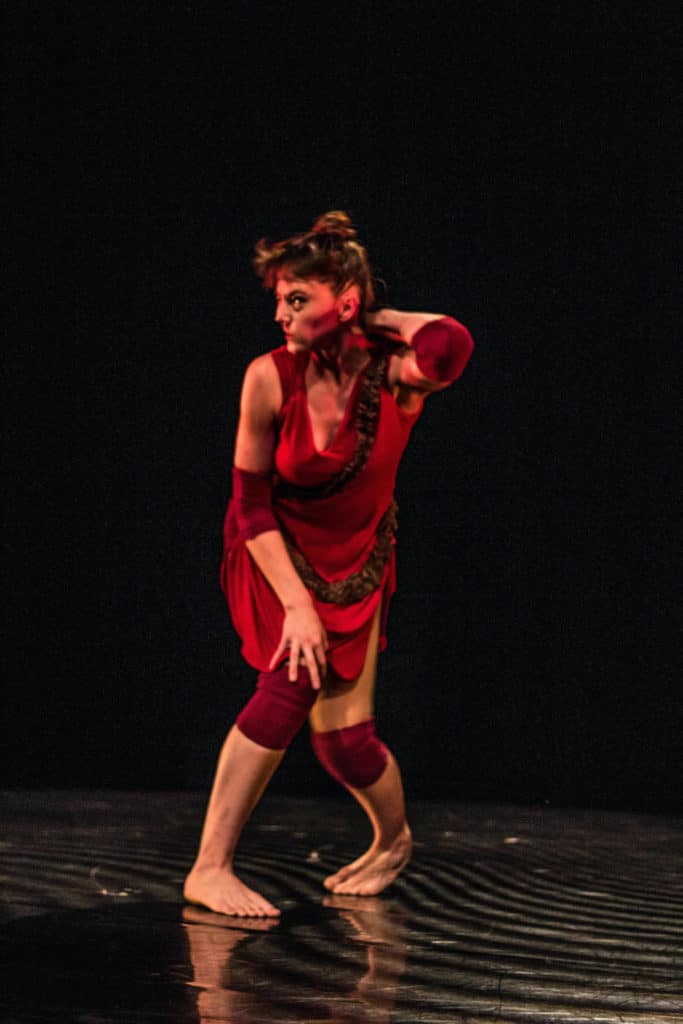
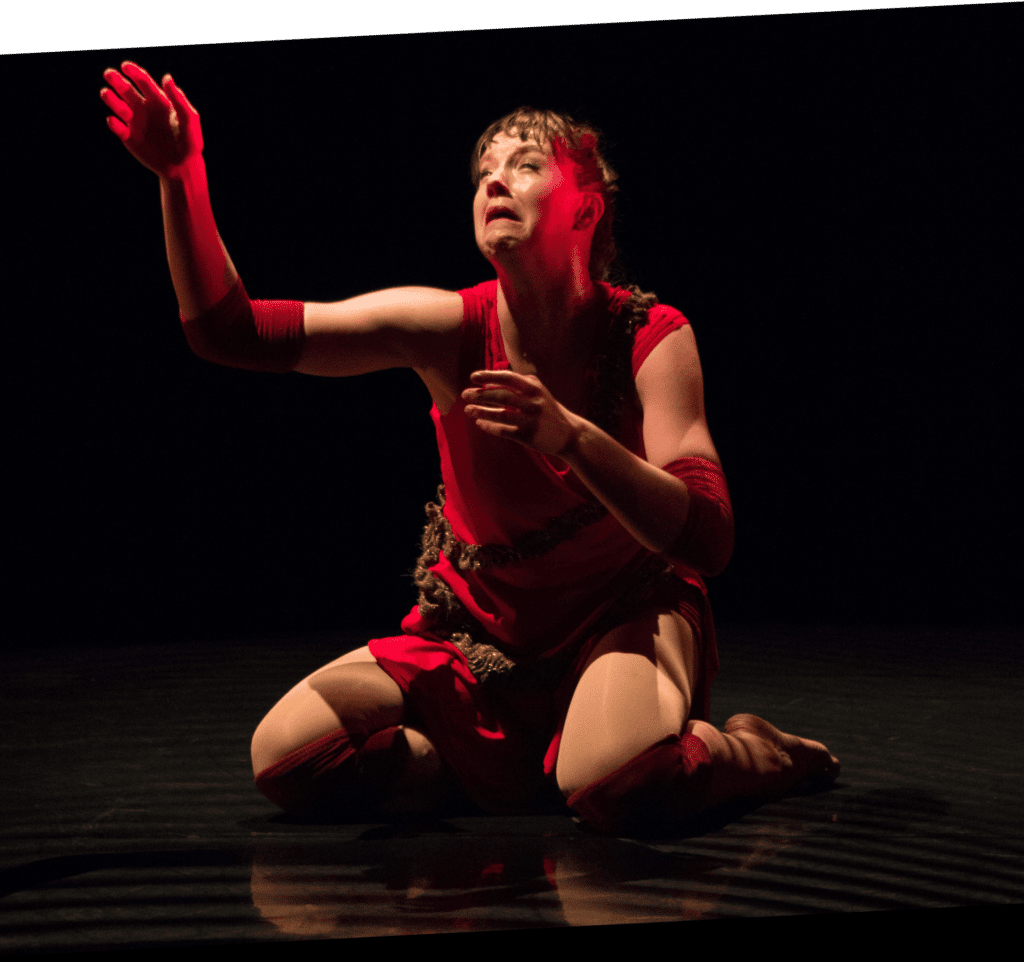
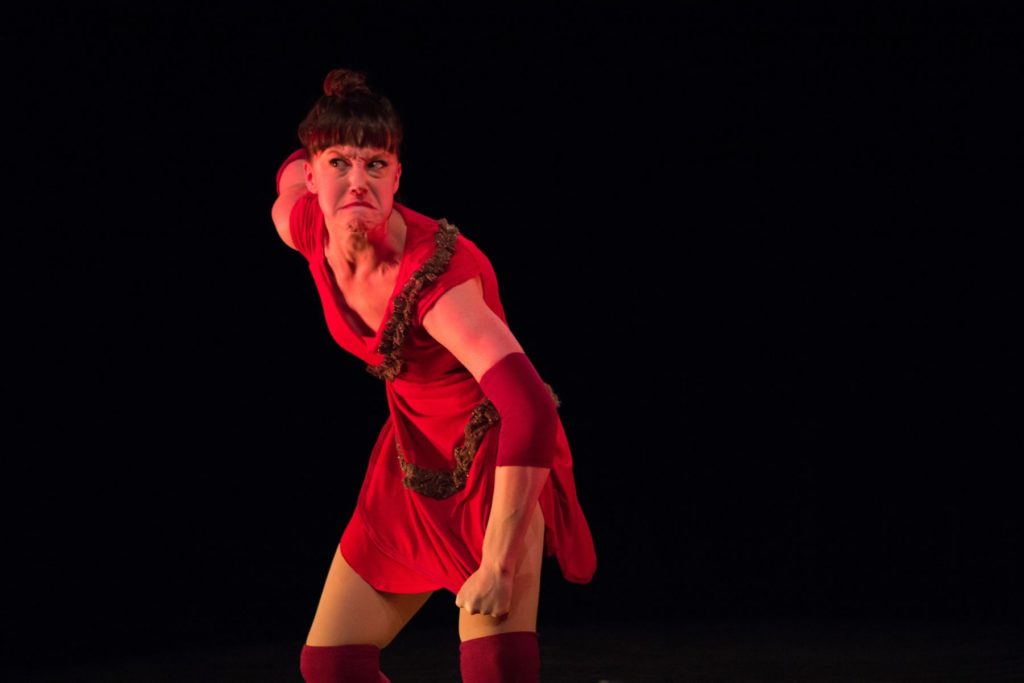
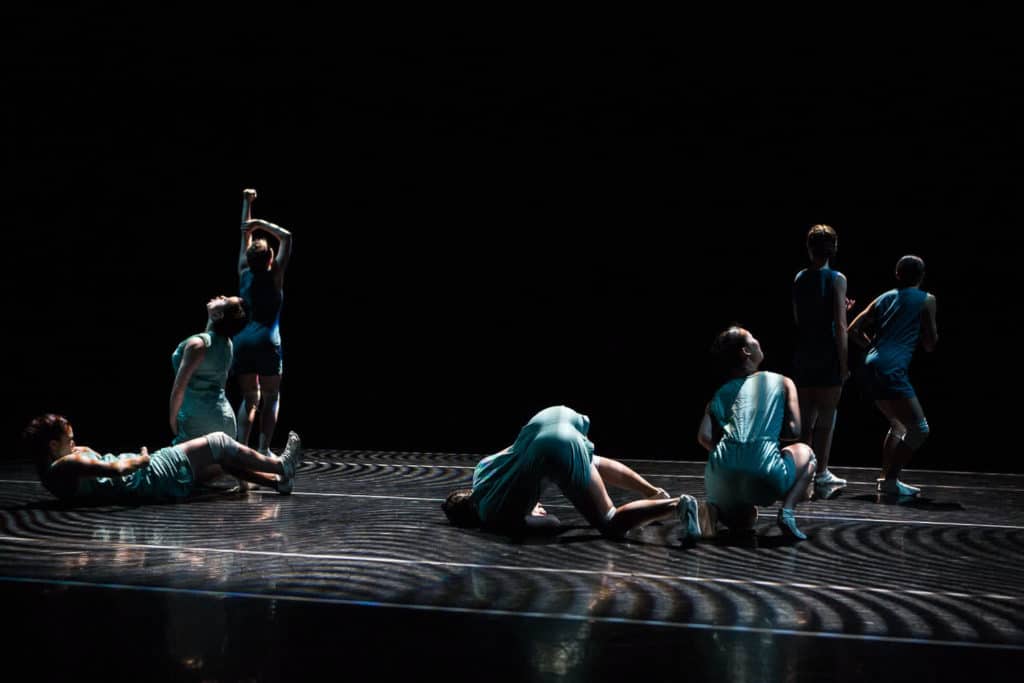
Choreographer: Davida Monk
Dancers: Tasha Danyluk, Sisa Madrid, Meaghann Michalsky, Camille Mori, Lindsay Oehlerking, Zahra Shahab, Brynn Williams
Music: Venture, Robert Normandeau
Costume Design: Robin Poitras
Costume Construction: Carey Lees
Choreographer: Davida Monk
Dancers: Nicole Charlton-Goodbrand, Valentia Dimitriou, Jared Tobias Herring, Meghann Michalsky, Rufi O. Rodriguez, Katharina Schier
Music: Robert Normandeau
Costume Design: Robin Poitras
Costume Construction: Carey Lees, Angela Dale
Photographer: Tim Nguyen
In Japanese folklore the fox appears both as Inari, god of rice and protector of crops, and as a mischievous spirit that disguises itself as a woman to bewitch the unwary and the gullible. I imagine that the dance unfolds in the gardens of Kyoto and Higashihiorshima (Rhyoan-ji, Shigimori House and Kamoizumi House). Embracing the aesthetic values of stillness, contemplation, asymmetry and embodied essence, Moon in the Fox’s Garden contains and withholds, flows and explodes in the expression of the deep nature of being.
Commissioned by the University of Calgary.
Photographer: Natalia Babanova
Choreographer: Davida Monk
Dancers: Helen Husak, Walter Kubanek
Musician: Bill Horist
Costume Design: Robin Poitras
Costume Construction: Carey Lees
Dream Pavilion movement vocabulary arose from a process in which the dancers embodied the physicality of netsuke, tiny Japanese sculptures of exquisite detail. Netsuke depict a range of subjects from flora and fauna to fantastical beasts and mythical beings, captured in moments of powerful emotional expression. In Dream Pavilion my desire is to bring netsuke to life in a world of juxtaposition and transformation that touches the depths of human desire, fear, playfulness and imagination.
Photographer: Tim Nguyen
“Intense, exaggerated facial expressions and articulate, intricate movement make for a definitely memorable piece.” Kortney Swan
“Bill Horist, a musician extraordinaire who will blow your mind” Taylor Ritchie
Choreographer: Davida Monk
Commissioned by Land’s End Ensemble
Dancers: Hilary Maxwell/Davida Monk
Music: Habil-Sajahy, Franghiz Ali-Zadeh
Under Cover of Darkness explores the counterpoint of tensions in the musical score and confinement in the performers’ costume. Commissioned and premiered by Land’s End Ensemble, this work was toured by the Prairie Dance Circuit in 2010.
Photographer Leif Norman
Choreographer: Davida Monk
Dancers: Veronica Benz, Jenn Jaspar, Helen Husak, Hilary Maxwell
Composer: Allan Gordon Bell
Set Design: Douglas McCullough
Video: Arthur Nishimura
Lighting Design: Brian MacNeil
The Land Quartet is a four-part work that explores the relationship between human beings and the natural environment. Each dance is 20 – 25 minutes long. It is an ensemble work featuring a cast of four dancers and the integration of set, video and light design, as well as original scores by Allan Gordon Bell. Creation of this large-scale work began in 2009 and was generously support by the Canada Council of the Arts and Dancers’ Studio West.
Photographer Glen Co
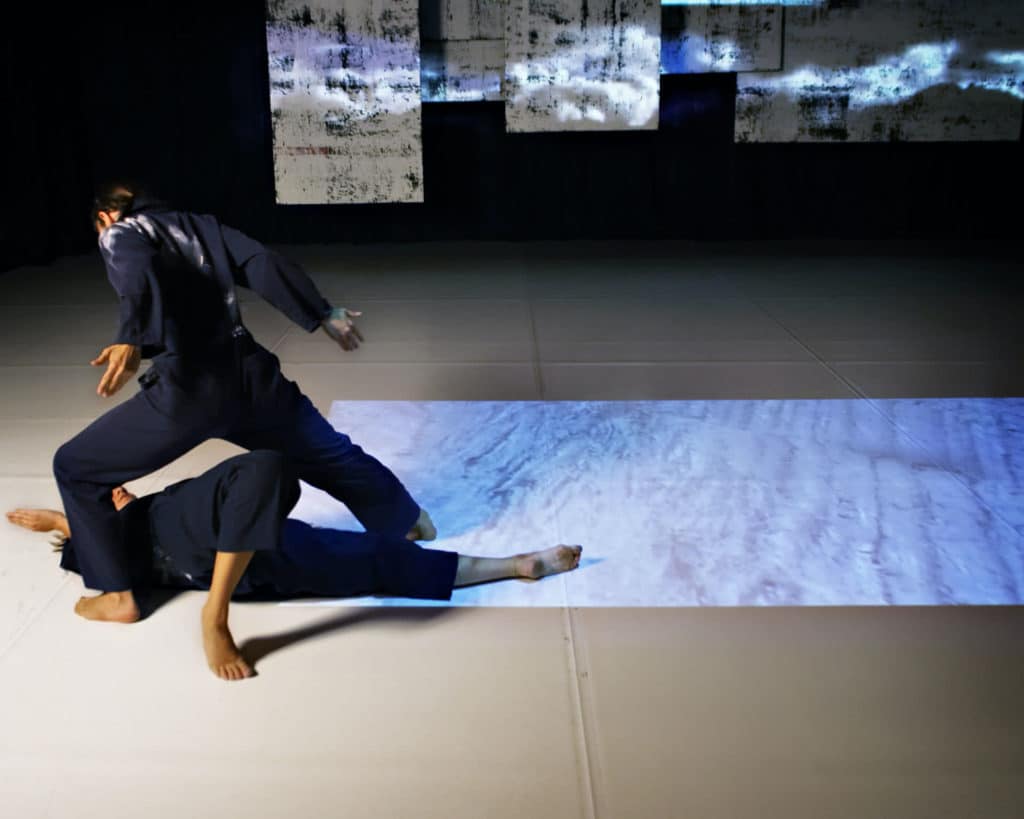
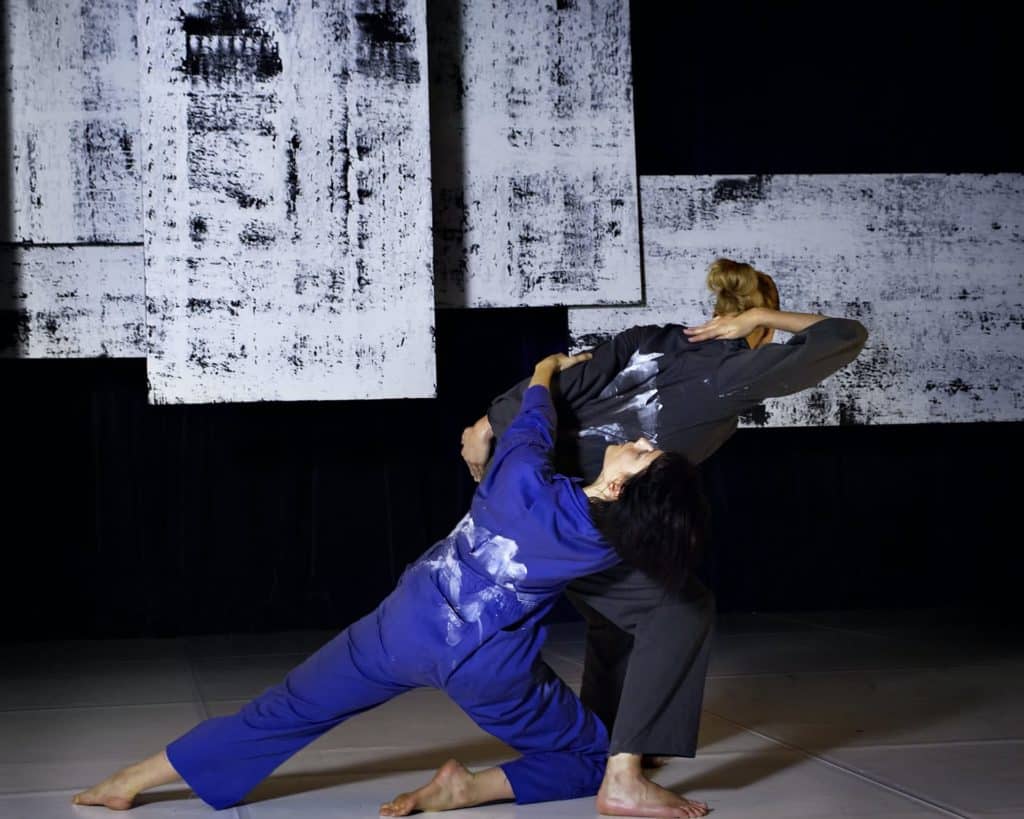
Prairie (2009) draws its fluid movement and animalistic character from the spatial qualities, the music, and the embodied experience of the open prairie.
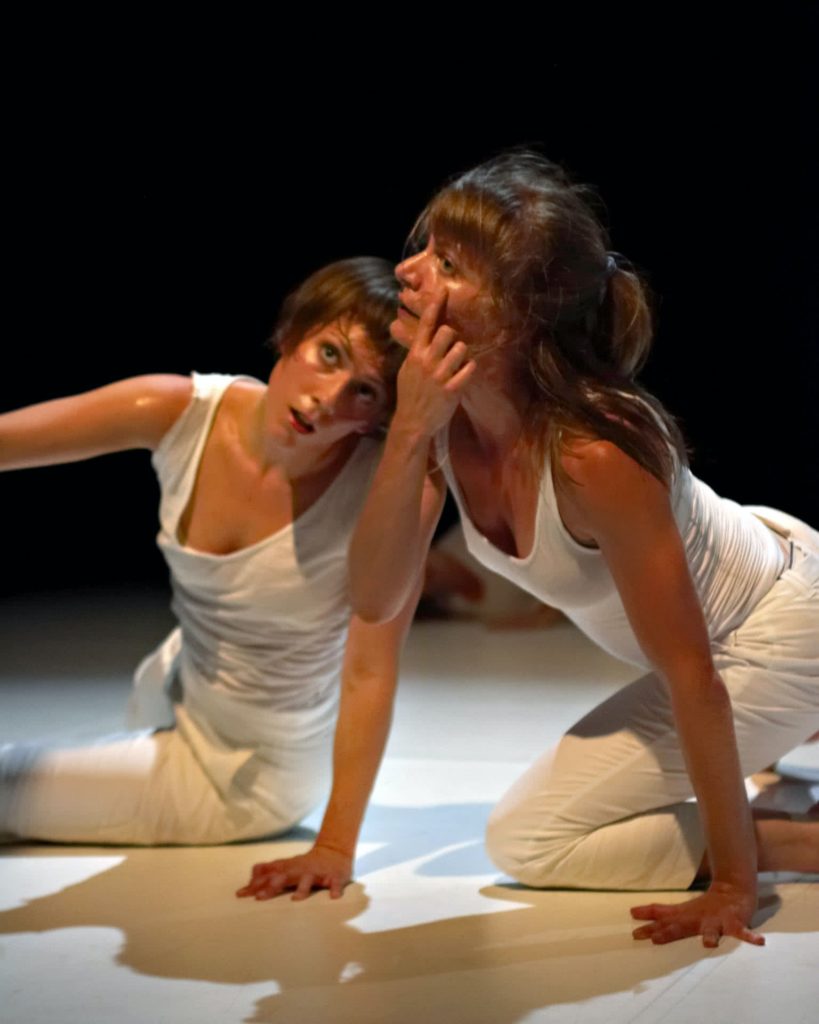

Forest (2010/2011) develops through a desire to move from rootedness. It is driven by the human response to the beckoning forms, to the mystery and the dazzling beauty of the forest.
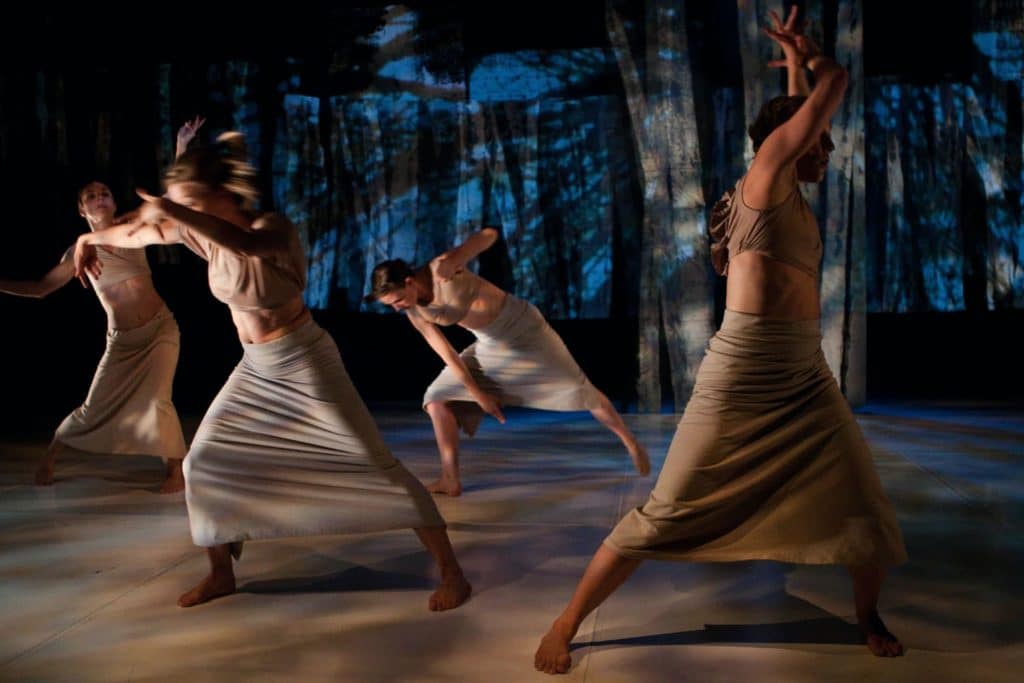

Meridians (2011) considers the landscape of the human body. The movement language derives from pathways of the body’s design. The dancers discover the symbiosis of the inner and outer worlds, and the delight of embodiment.
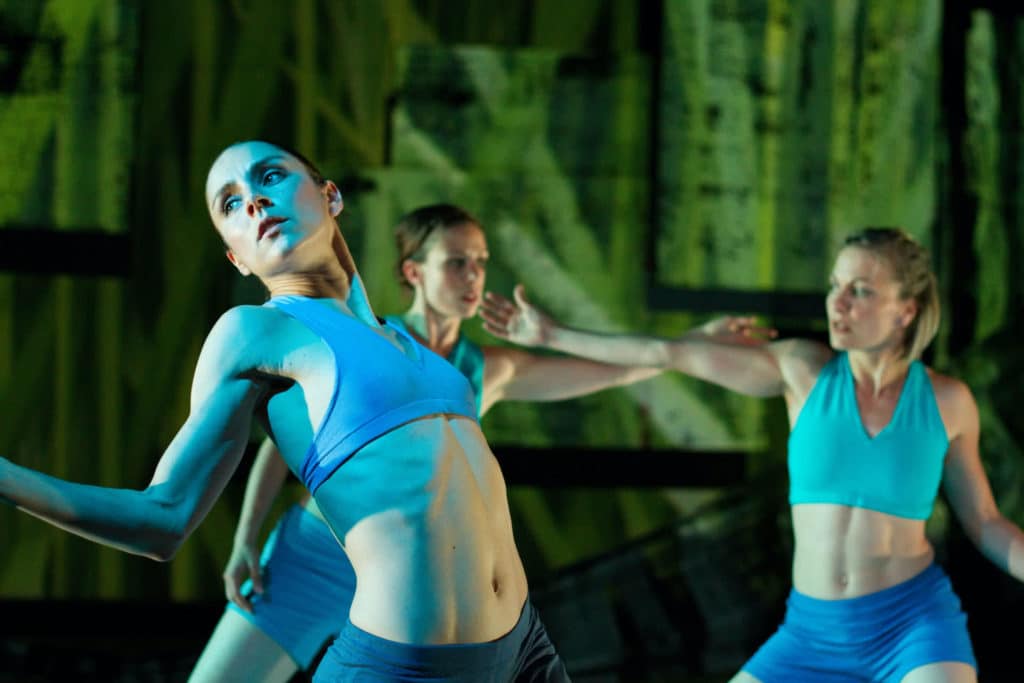
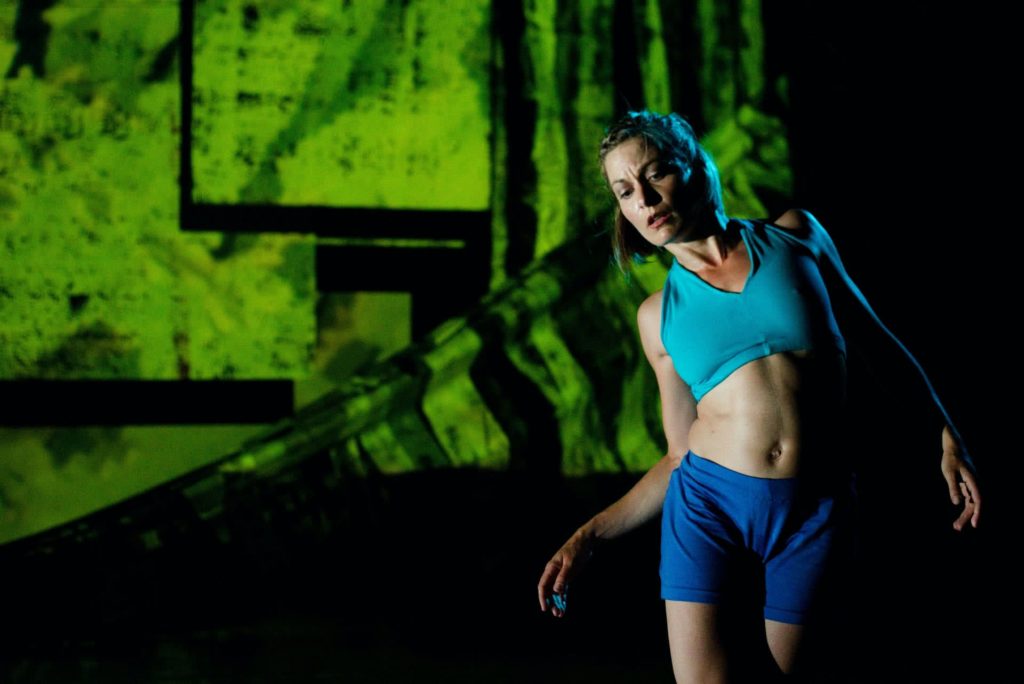
The Experiments consist of nine works: three solos, three duets and three trios all to piano music.
Choreographer: Davida Monk
Dancers: Naomi Brand, Lauren Deimer, Kirsten Wiren
Music: Grygori Ligeti, Howard Bashaw, Olivier Messiaen
Lighting: Jean Philippe Trépanier
Choreographer: Davida Monk
Dancers: Erin Cowan, Melissa Monteros, Christine Medina, Davida Monk, Johanna Riley
Music Advisor: Allan Gordon Bell
Lighting Design: Jean Philippe Trépanier
Set : Douglas McCullough
Costume : Engelina Wehnes
The Weathering Suite is a group of dances that flow seamlessly from one to the next, as do the elemental phenomena of the ever-changing sky. Expressing an intimate rapport with the patterns of weather, the movement of the dancers fluctuates between an exchange of essential energies and a sensuous human response to them. It is a contemplative ritual for five dancers.
“The ethereal opening, as a prayerful invocation of the Earth’s spirit, sets the tone for a work that is defined primarily by its sense of wonder.” Holly Harris, Uptown Magazine, Winnipeg
Choreographer: Davida Monk
Dancers: Alanna Jones, Su-Lin Tseng
Musician: Bill Horist
Lighting Design: Jean Philippe Trépanier
Costume Design: Conroy Nachtigall
Acting Coach: Chris Hunt
Text Consultant: Jan Zwicky
Text: Lyric Philosophy, Jan Zwicky
Vocal Workshop: Richard Armstrong
LYRIC takes its cues from the work Lyric Philosophy by Jan Zwicky in which she champions the non-rational meanings wrought through the artistic process. The dance poses questions about perception, language, chance, intellect and intuition as the dancers undergo transformations through discovery. Voice work, props and set, movement and live treated-electric guitar are each integrated into the theatrical experience as a means of exploration.
“cyrstallized, subtle and visionary.” Dena Davida, Tangente, 2001